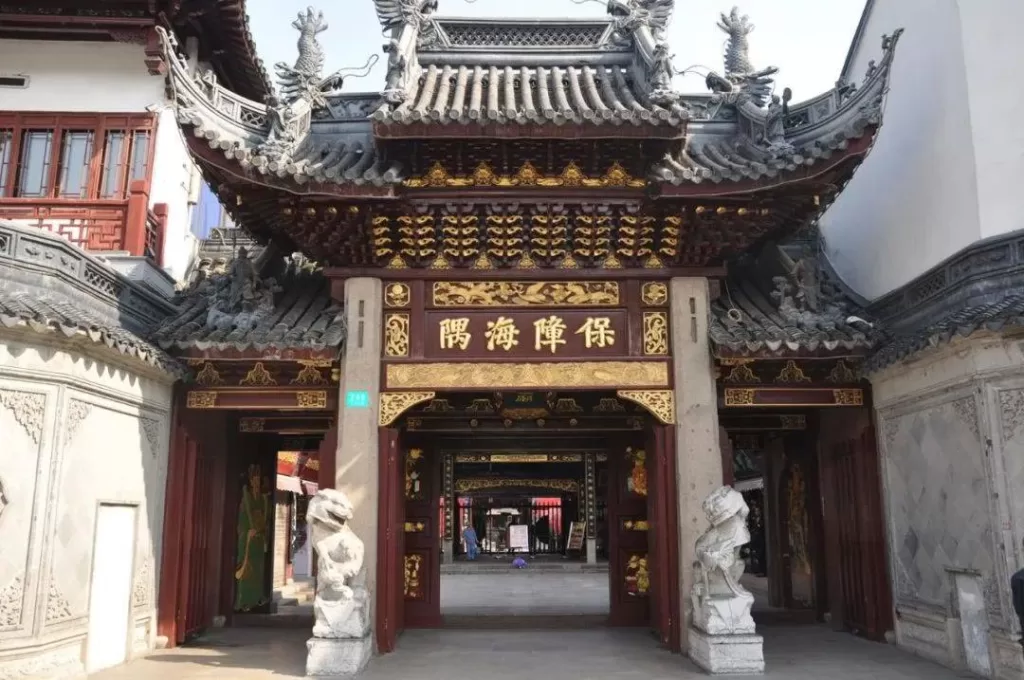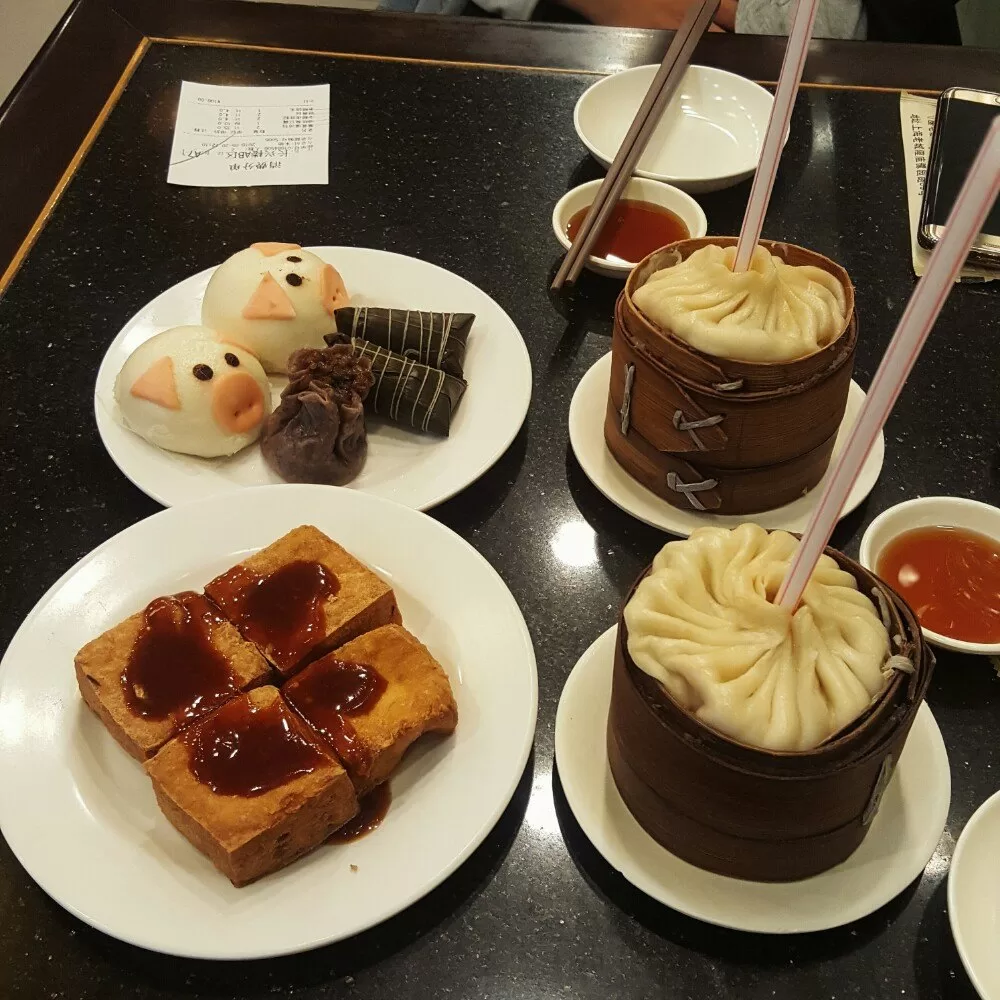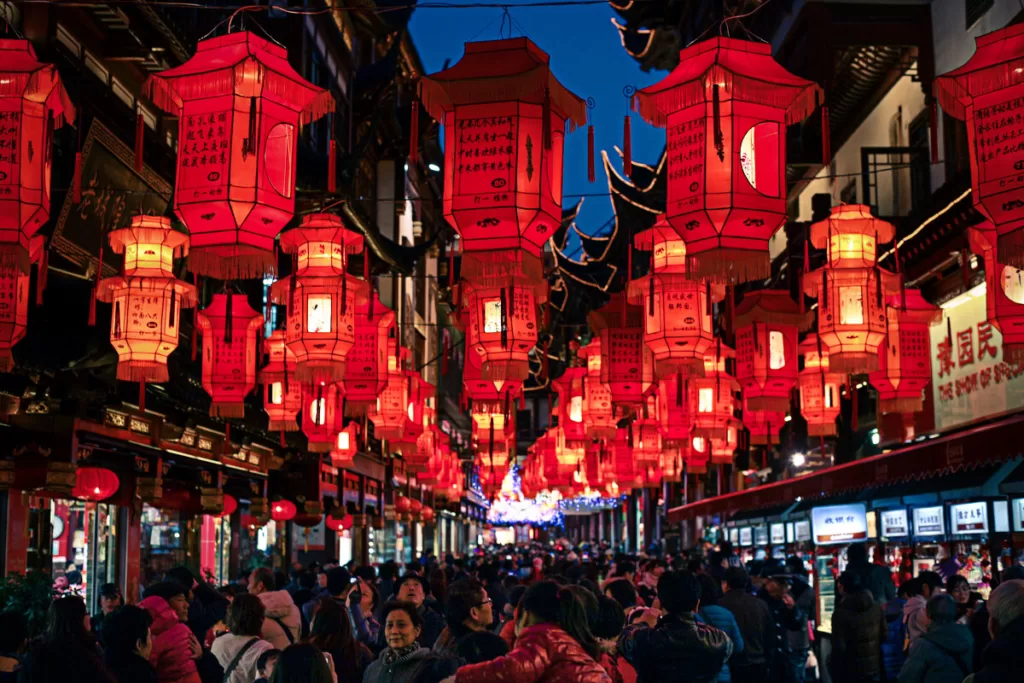The City God Temple (城隍庙), nestled in Shanghai‘s Huangpu District, holds a legendary history dating back over 2,000 years to the Three Kingdoms period. The temple, oriented north to south, spans an area of around 3,000 square meters. Temples dedicated to the city god were established in Shanghai as early as the Tang Dynasty. In 1994, the City God Temple underwent restoration, finally opening its doors to believers on January 31, 1995.
The temple complex encompasses nine main halls, including the Grand Hall, Yuanchen Hall, Parents Hall, Guan Yu Hall, and Wenchang Hall. These structures, built in a typical southern architectural style with red walls and tiled roofs, maintain the grandeur and layout reminiscent of Ming Dynasty architecture. Elaborate eaves, colorful wooden beams, green tiles, and red-painted eaves contribute to its majestic appearance.
The City God Temple area bustles year-round, as it’s not just a religious site but also a renowned commercial hub. Several wholesale shopping centers, comprehensive malls, numerous jewelry stores, and gold shops line the area. Additionally, it hosts a variety of well-established eateries and shops selling an array of Shanghai’s local specialties, making it a haven for both tourists and locals seeking unique cultural experiences and diverse shopping opportunities.
Table of Contents
- Basic Information
- Location and Transportation
- History of City God Temple
- Who is enshrined
- Highlights of Shanghai City God Temple
- Vlog about Shanghai City God Temple
- Useful Tips Summarized from Reviews
- Attractions near the CIty God Temple
- Other Temples in Shanghai
Basic Information
| Estimated Length of Tour | 1 hour |
| Ticket Price | 10 RMB |
| Opening Hours | The temple is open from 8.30 to 16.30. But the commercial areas around it are accessible throughout the day |
| Telephone Number | 0086-021-63284494 |
Location and Transportation
The City God Temple of Shanghai is located in the heart of Shanghai’s Old Town, in the Yu Garden area of Huangpu District. The specific address is No. 249, Fangbang Middle Road, Huangpu District. It is easily accessible by public transportation, with several bus and metro lines stopping nearby.
Bus: Take Tourist line 1 or 3, get off at Chenghuangmiao Yuyuan Stop (City God Temple and Yuyuan Garden), and walk about 100 meters to the northeast to reach the tourist attraction.
Subway: Take subway line 10 or 14, get off at Yuyuan Garden Station, and walk about 500 meters to the southeast to reach the temple.
History of City God Temple
The history of the City God Temple dates back to the Tang Dynasty, when it was first built as a simple shrine to the City God. However, it was during the Ming Dynasty (1368-1644) that the temple began to take on its current form and became one of the most important religious sites in Shanghai.
Over the centuries, the City God Temple has been destroyed and rebuilt several times due to wars, fires, and natural disasters. The temple that stands today was rebuilt in the Qing Dynasty (1644-1912) and underwent a major renovation in the 1920s.
During the Qing Dynasty, the City God Temple also served as a center for local government and commerce, with many shops and restaurants located around its grounds. It was a bustling hub of activity, with merchants and visitors coming from all over the country to do business and pay their respects to the City God.
Who is enshrined
The City God Temple enshrines three main deities, each holding a significant place in Chinese history and mythology.
The first deity enshrined in the temple is Huo Guang (霍光), a prominent figure during the Western Han Dynasty. Huo Guang served as regent for the young emperor and played a crucial role in stabilizing the empire during a period of political turmoil. He is revered as a wise and just ruler who always put the needs of the people first.
The second deity enshrined in the temple is Qin Yubo (秦裕伯), a local hero who lived during the Ming Dynasty. Qin Yubo was famous for his bravery and loyalty, and he was said to have defended Shanghai against pirates and bandits. He is revered as a symbol of courage and resilience, and his memory is cherished by the people of Shanghai.
The third deity enshrined in the temple is Chen Huacheng (陈化成), a general who fought against the British during the First Opium War in the mid-19th century. Chen Huacheng is revered as a martyr for his sacrifice in defending China’s sovereignty, and his memory is an important reminder of the struggles and sacrifices that the Chinese people have made to protect their country.
Highlights of Shanghai City God Temple
Traditional Chinese Architecture

The City God Temple showcases a splendid example of traditional Chinese architecture, with its various halls and structures reflecting centuries of history and cultural significance. The Shanmen, or main gate, was constructed in the 14th year of the Ming Dynasty’s Jiajing era (1535), boasting over 450 years of history. The gate’s stone pillars and wooden beams bear witness to the craftsmanship of the time. Inscribed with golden characters reading “保障海隅” (Ensuring Coastal Security), the inscription was originally composed by Feng Bin, the county magistrate of Shanghai during the Ming Dynasty.
The main hall of the City God Temple features a prominent sign reading “城隍庙” (City God Temple). Inside the hall, a seated statue of General Huo Guang, the god presiding over Jinshan, is enshrined. Flanking him are the civil judge and military judge, while the positions of day and night supervisors are also represented.
The Taishui Hall, also known as the Yuanchen Hall or the Sixty Jiazi Hall, is associated with auspicious moments and signifies favorable times. Dedicated to the god of Taishui, this hall is linked to the annual fortune of individuals.
Cultural Relics

The City God Temple of Shanghai is not only a religious site, but also a cultural relic museum, housing a wide range of cultural relics from different periods of Chinese history. Some of the most notable artifacts include stone inscriptions, ancient bronze statues, and Ming and Qing dynasty porcelain. These artifacts not only showcase the art and craftsmanship of ancient China but also provide insights into the beliefs and customs of people during those times. Visitors can also see traditional Chinese calligraphy, paintings, and other artworks that have been carefully preserved over the years.
Local Food and Souvenir Shops

The area surrounding the City God Temple of Shanghai is a bustling marketplace filled with food and souvenir shops, offering visitors a unique shopping and dining experience. The streets are lined with vendors selling a variety of local delicacies such as steamed buns, dumplings, and rice cakes, as well as snacks like candied fruits and roasted nuts. Visitors can also find many souvenir shops selling traditional Chinese crafts and souvenirs, including paper-cuttings, calligraphy brushes, and silk fans. In addition, there are tea houses, restaurants, and street food stalls offering a wide range of local cuisine.
Lantern Festival

The Lantern Festival is one of the most important festivals celebrated at the City God Temple of Shanghai. It takes place on the 15th day of the first lunar month and marks the end of the Chinese New Year celebrations. The temple is adorned with colorful lanterns, and visitors can participate in various activities, such as writing and hanging lanterns, solving lantern riddles, and watching lion and dragon dance performances. The highlight of the festival is the releasing of lanterns, where visitors write their wishes on lanterns and release them into the night sky.
Vlog about Shanghai City God Temple
Useful Tips Summarized from Reviews
Use Public Transportation: Public transportation is the best option for getting to Shanghai City God Temple. Traffic congestion from Henan Middle Road to Nanjing Road can be severe, so it’s advisable to avoid driving. Follow the crowds, and you’ll easily find your way.
Bring Coins for Offerings: Make sure to bring some coins with you, as there are various opportunities for offerings throughout the temple. In the back hall of the temple, there are statues representing the Chinese zodiac signs where visitors can make offerings. Additionally, it’s customary to leave a donation at the main hall and other shrines as a token of respect. If you forget to bring coins, there are self-service coin exchange machines available near the back hall.
Visit in the Afternoon: It’s highly recommended to visit Shanghai City God Temple around 4:00 PM. At this time, it’s not yet dark, allowing you to capture the temple without the lights turned on. The difference between the temple with and without lights is striking, and the nighttime view is equally impressive.
Try Local Delicacies: Don’t miss the opportunity to sample some of the local delicacies while visiting the temple. Highly recommended dishes include xiaolongbao (soup dumplings), shengjianbao (pan-fried buns), traditional Shanghai-style spare ribs with rice cakes, and Qingtuan (glutinous rice balls). These foods offer a taste of authentic Shanghai cuisine.
Convenient Access to Yuyuan Garden: After exploring Shanghai City God Temple, you can exit through the back door to reach Yuyuan Garden directly without having to take a detour.









